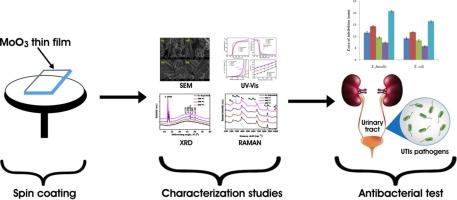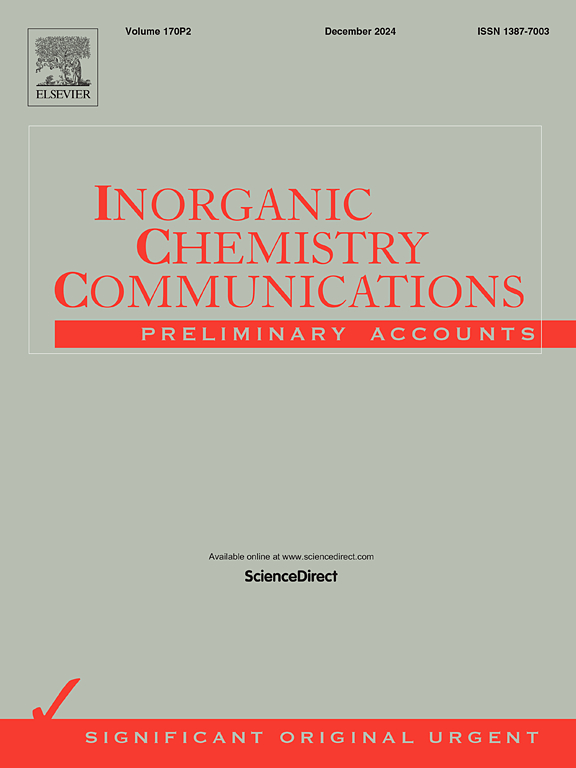旋涂纳米 MoO3 薄棒:退火温度对物理性质和尿路病原体抗菌活性影响的深入研究
IF 4.4
3区 化学
Q1 CHEMISTRY, INORGANIC & NUCLEAR
引用次数: 0
摘要
最近,纳米结构材料在医疗保健相关领域的应用不断获得广泛认可,这是因为它们在防止细菌生长方面具有很强的生物活性,从而最大限度地减少了细菌感染的传播。在本研究中,我们评估了退火温度对三氧化钼(MoO3)纳米结构的一些表面特性以及对两种尿路感染(UTIs)病原体的抗菌效果的影响。样品的一些表面结构研究表明,无定形的巢状 MoO3 纳米粒子在退火后发生了相变,变成了清晰的纳米棒。根据退火温度的不同,沉积薄膜的平均结晶尺寸在 35.4 到 52.1 nm 之间。紫外-可见太阳光谱的光学研究表明,沉积的 MoO3 薄膜具有可调的光带结构,带隙和厄巴赫能值分别在 2.90 至 3.21 eV 和 0.88 至 0.90 eV 之间,具体取决于退火温度。涂有 MoO3 的薄膜对革兰氏阳性(E. feacalis)和革兰氏阴性(E. coli)UTI 细菌病原体的抗菌作用显示出极高的效率,但随着退火温度的升高,效率有所降低。此外,与革兰氏阴性菌相比,对革兰氏阳性菌的活性更强。这些结果有力地表明,MoO3 纳米结构是一种潜在的抗菌剂,可用于控制尿路感染。该研究再次证实,MoO3 薄膜的表面微观结构和光带结构可以通过一些沉积热处理进行定制。研究还揭示了通过退火工艺可以定制旋涂 MoO3 纳米粒子的抗菌效力。本文章由计算机程序翻译,如有差异,请以英文原文为准。

Spincoated MoO3 nanostructured thinly rods: An insight into effect of annealing temperature on physical properties and antibacterial activity against urinary tract pathogens
Recently, the use of nanostructured material has continued to gain huge recognition in healthcare-related fields owing to their strong biological activity in the prevention of bacterial growth, thus minimizing the spread of bacterial infections. In this current research, we evaluated the effect of annealing temperature on some surface properties and antimicrobial efficacy of molybdenum trioxide (MoO3) nanostructure against two urinary tract infections (UTIs) pathogens. Some surface structural investigation of the samples revealed an amorphous nestlike MoO3 nanoparticle which exhibited a phase change into well-defined nanorods upon annealing. The deposited films’ average crystallite sizes were found within the range of 35.4 to 52.1 nm depending on annealing temperature. Optical studies from UV–visible solar spectra revealed the deposited MoO3 film exhibited tuneable optical band structure with band-gap and Urbach energy values between 2.90 to 3.21 eV and 0.88 to 0.90 eV, respectively, depending on annealing temperature. The antimicrobial action of MoO3-coated films towards the Gram-positive (E. feacalis) and Gram-negative (E. coli) UTI bacteria pathogens revealed great efficiency that decreased with an increase in annealing temperature. Moreover, superior activity was recorded against Gram-positive bacteria when compared to Gram-negative bacteria. These results strongly indicate the use of MoO3 nanostructure as a potential antimicrobial agent for the control of urinary tract infections. The study reaffirmed surface microstructure and optical band structure of MoO3 film can be tailored by subjecting it to some deposition heat treatments. It also unveiled the antimicrobial potencies of the spincoated MoO3 nanoparticles can be tailored via annealing processes.
求助全文
通过发布文献求助,成功后即可免费获取论文全文。
去求助
来源期刊

Inorganic Chemistry Communications
化学-无机化学与核化学
CiteScore
5.50
自引率
7.90%
发文量
1013
审稿时长
53 days
期刊介绍:
Launched in January 1998, Inorganic Chemistry Communications is an international journal dedicated to the rapid publication of short communications in the major areas of inorganic, organometallic and supramolecular chemistry. Topics include synthetic and reaction chemistry, kinetics and mechanisms of reactions, bioinorganic chemistry, photochemistry and the use of metal and organometallic compounds in stoichiometric and catalytic synthesis or organic compounds.
 求助内容:
求助内容: 应助结果提醒方式:
应助结果提醒方式:


